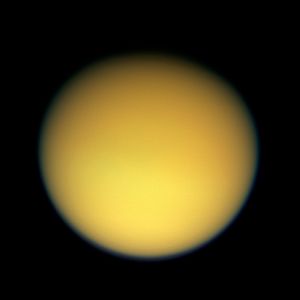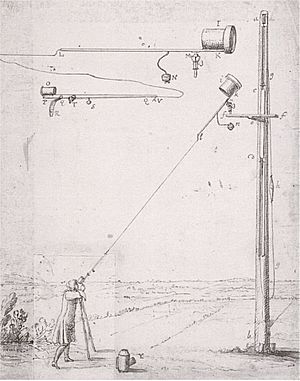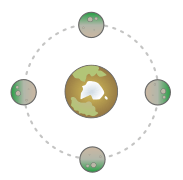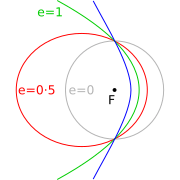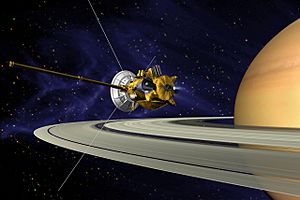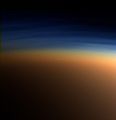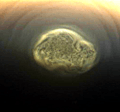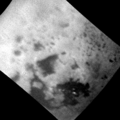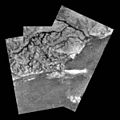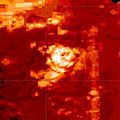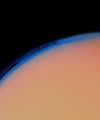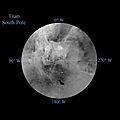Titan (moon) facts for kids
Titan is a fascinating moon that orbits the planet Saturn. It was discovered a long time ago, on March 25, 1655, by a scientist named Christiaan Huygens. What makes Titan super special is that it's the only moon in our entire Solar System that has a thick atmosphere, just like Earth!
Titan is the biggest moon of Saturn and the second largest moon in our Solar System. It's even bigger than the planet Mercury! Titan is about 5,150 kilometers wide. It travels around Saturn at a distance of about 1,221,865 kilometers.
Even though Titan has an atmosphere, humans couldn't breathe its air. It's extremely cold and contains gases like nitrogen and methane, which are not safe for us. Titan is also the only place in the Solar System, besides Earth, that has lakes and lots of liquid on its surface. But these lakes aren't filled with water; they're full of liquid methane!
Contents
Discovering Titan
Titan was found on March 25, 1655, by Christiaan Huygens, an astronomer from the Netherlands. Years before, in 1610, Galileo Galilei had found four moons orbiting Jupiter. This made Huygens want to find new moons too. Huygens had also made telescopes much better, so he thought he might be able to spot something new.
Christiaan and his brother, Constantijn, started building their own telescopes in 1650. Using the very first telescope he built, Christiaan Huygens was able to see Titan. At first, he called it "Luna Saturni," which means "Saturn's moon." He didn't know there would be more than one! Over the years, many other moons were discovered around Saturn. Today, this moon is known as "Titan" or "Saturn VI." The name "Titan" and the names of Saturn's other moons come from ancient Greek legends.
What Titan is Made Of
Titan is the only moon in our Solar System with a thick atmosphere. An atmosphere is the layer of gases that surrounds a planet or moon. When the spacecraft Voyager 1 visited Titan on November 12, 1979, it showed that Titan's surface is hidden under an atmosphere that is 900 kilometers thick. Before this, everyone thought Titan was the biggest moon in the Solar System. Now we know it's the second biggest, after Ganymede, one of Jupiter's moons.
Even though Titan is slightly smaller than Ganymede, it's still very large. It's also similar in size to Callisto, another of Jupiter's moons. Titan is even bigger than the planet Mercury! However, it only has half as much mass (it's much lighter). Because Titan isn't very heavy for its size, scientists think it's made of lighter materials, like frozen water and ammonia. Some scientists even believe there's a huge ocean of liquid water and ammonia hidden deep beneath its surface. They think there might even be some form of life in this hidden ocean!
At its very center, Titan has a rocky core that is about 3,400 kilometers thick. This core is made of materials like silicates and metals. The gravity on Titan is much weaker than on Earth. If you could jump 1 meter high on Earth, you would be able to jump 7 meters high on Titan!
How Titan Moves
It takes Titan 15 days and 22 hours to travel all the way around Saturn. This is almost the same amount of time it takes Saturn to spin around once. This special movement is called "synchronous rotation." It means that the same side of Titan is always facing Saturn.
The path Titan takes as it moves around Saturn is very close to a perfect circle, but not quite. Scientists use the word "eccentricity" to describe how round a moon's or planet's path is. If a path has an eccentricity of 0 (zero), it's a perfect circle. If the eccentricity is more than 0, the path is less round. Titan's eccentricity is 0.028, which is very close to zero, meaning its path is almost a perfect circle.
-
An example of "synchronous rotation": the moon takes the same time to orbit around the planet as the planet takes to spin around its own axis. This means that the same side of the moon is always pointed at the planet and, in this example, people living on the planet will never be able to see the green side of the moon.
The Cassini-Huygens Mission
On July 1, 2004, the Cassini-Huygens spacecraft reached Saturn and began orbiting it. Then, on December 25, 2004, the Huygens probe separated from the Cassini spacecraft and started its journey towards Titan. It successfully landed on Titan's surface on January 14, 2005. The probe landed on a dry area, but it confirmed that large amounts of liquid exist on the moon.
The Cassini spacecraft continued to gather information about Titan and other icy moons. It even found proof that the moon Enceladus had water shooting out from its geysers! In July 2006, Cassini also proved that Titan has hydrocarbon lakes, especially near its north pole. In March 2007, it found a huge hydrocarbon lake, as big as the Caspian Sea, near the north pole. This lake of liquid methane was named Kraken Mare. In 2009, NASA even shared a photo showing sunlight reflecting off the surface of this lake. This was the first time we ever saw liquid reflecting light on another world!
In 2012, scientists at NASA discovered that Titan gives off a faint glow of light. They believe this glow is caused by complex chemical reactions happening in Titan's atmosphere. This type of light is called an "airglow."
Related pages
Images for kids
-
Christiaan Huygens discovered Titan in 1655.
-
Atmospheric polar vortex over Titan's south pole.
-
Ligeia Mare – SAR and clearer despeckled views.
-
Voyager 1 view of haze on Titan's limb (1980).
-
Global map of Titan – with IAU labels (August 2016).
See also
 In Spanish: Titán (satélite) para niños
In Spanish: Titán (satélite) para niños


